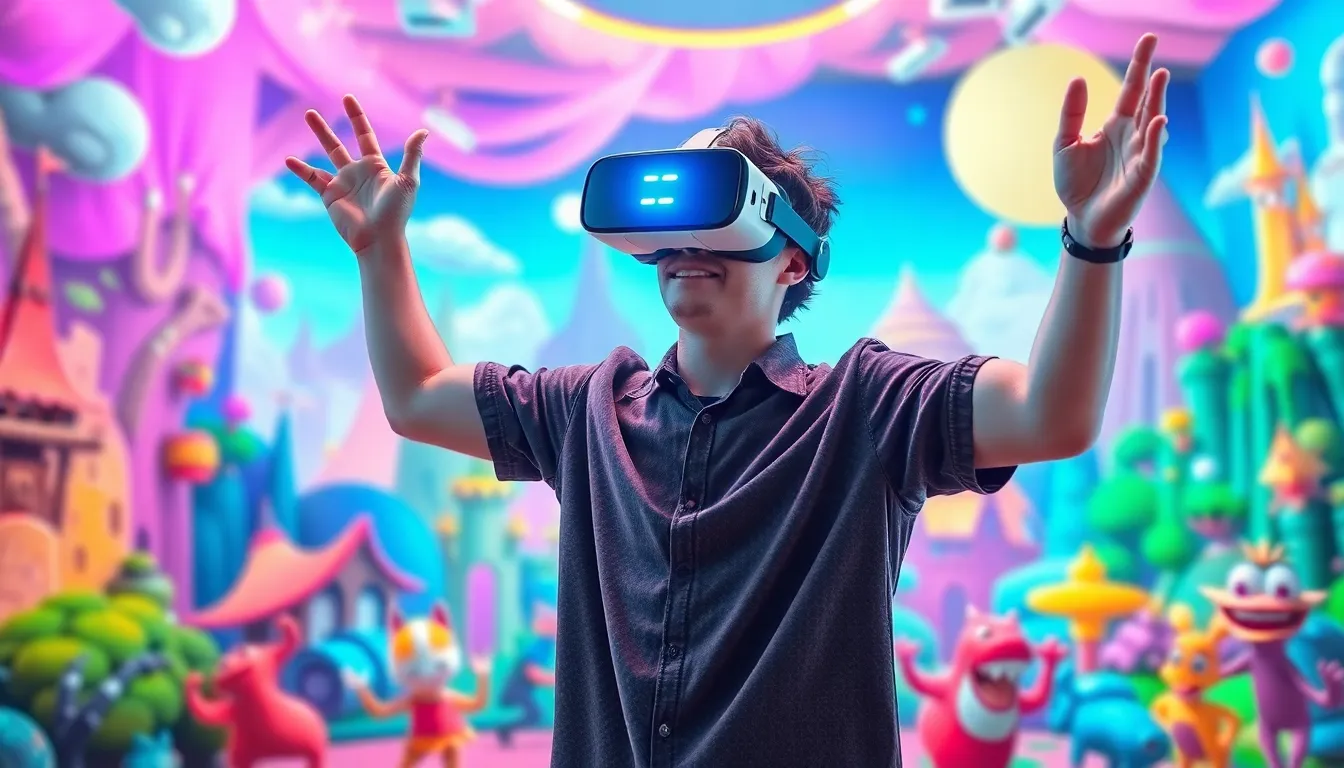Imagine stepping into a world where you’re not just a spectator but the hero of your own epic tale. VR storytelling games do just that, whisking players away on immersive adventures that blur the lines between reality and fantasy. With a headset on, one can explore enchanted forests, solve mysteries, or even save the universe—all while sitting comfortably on the couch in their pajamas.
These games aren’t just about flashy graphics or cool gadgets; they’re about crafting experiences that tug at the heartstrings and tickle the funny bone. Whether it’s a gripping narrative or quirky characters, VR storytelling games offer a unique blend of entertainment and engagement. So grab your headset and prepare to dive into a world where every choice you make shapes your story. Who knew getting lost in a game could be this much fun?
Table of Contents
ToggleOverview of VR Storytelling Games
VR storytelling games engage players in interactive narratives that blend gameplay with storytelling. They invite users to step into richly crafted worlds, often featuring diverse characters and intricate plots. Players become active participants, making choices that shape the course of the story.
These games utilize advanced technology to create immersive environments that captivate the senses. High-quality graphics and spatial audio enhance the storytelling experience, making each player’s journey unique. Interactive elements add layers to the narratives, allowing players to explore multiple outcomes based on their decisions.
Many popular titles, such as “Half-Life: Alyx” and “The Walking Dead: Saints & Sinners,” exemplify this genre’s potential. These games offer intense experiences, where emotional engagement often surpasses traditional gaming methods.
In VR storytelling, the user’s actions directly influence the story’s progression. Each decision impacts character relationships and plot developments. This interactivity fosters a deeper sense of connection, making players more invested in the outcomes.
Emerging technologies continue to expand the possibilities of VR storytelling. Innovations in artificial intelligence and voice recognition enhance character interactions, creating more realistic dialogues and responses. As the industry evolves, expectations for narrative depth and player agency are likely to rise.
Thus, VR storytelling games stand at the forefront of gaming evolution, merging interactive gameplay with immersive storytelling. They redefine player experiences, offering opportunities to explore narratives in ways that were previously unimaginable.
Key Features of VR Storytelling Games

VR storytelling games offer unique features that enhance the gaming experience. These elements create rich, engaging narratives that captivate players and make them feel part of the story.
Immersive Environments
Immersive environments define the essence of VR storytelling. Players enter vividly designed worlds that create a tangible sense of presence. Detailed graphics and dynamic landscapes allow for exploration like never before. Players can wander through unique locations, from mystical forests to futuristic cities, enhancing the feeling of realism. Atmospheric sound design further integrates players into these settings. The integration of 360-degree visuals and spatial audio elevates immersion, making interactions feel genuine and intuitive. Players connect deeply with the narrative through these strikingly crafted environments.
Interactivity and Player Choice
Interactivity and player choice drive the engagement in VR storytelling. Each decision made by players impacts the narrative, leading to diverse outcomes. They can influence character fates and story arcs through their choices. Real-time interactions foster a sense of agency, allowing players to shape their adventures organically. Players often encounter branching paths, ensuring that no two experiences are alike. Consequently, this level of interactivity enhances emotional investment in the storyline. It transforms players from passive observers into active participants, making the gameplay deeply personal and memorable.
Popular VR Storytelling Games
Several titles stand out in the VR storytelling genre, each offering unique narratives and immersive experiences.
Game 1: Half-Life: Alyx
“Half-Life: Alyx” sets a new standard for storytelling in VR. Players step into the shoes of Alyx Vance, navigating a dystopian city under alien control. The game features stunning graphics and intricate puzzles that enhance narrative depth. Engaging combat mechanics allow players to interact with the environment creatively. Emotional stakes emerge from each choice, reinforcing investment in the storyline. Reviews highlight its groundbreaking integration of character development and gameplay.
Game 2: The Walking Dead: Saints & Sinners
“The Walking Dead: Saints & Sinners” immerses players in a world devastated by a zombie apocalypse. Choices dictate survival outcomes, influencing character fates and progression. Players utilize crafting systems for weapons and gear, enriching the survival experience. The game’s atmosphere pulls players into tense encounters, demanding quick thinking and strategy. Responses from players emphasize the emotional turmoil faced during crucial decisions. Rich storytelling coupled with heart-pounding action creates a memorable experience.
Game 3: Moss
“Moss” offers a charming adventure through fantastical landscapes. Players control a young mouse named Quill who embarks on a quest to rescue her uncle. Unique mechanics include puzzle-solving and exploration while players guide Quill through a vibrant world. Interactions with the environment feel magical, aided by detailed graphics and enchanting audio design. This game emphasizes companionship and heroism as players witness Quill’s courage. Reviews note its ability to forge personal connections, enriching the gameplay experience.
Impact of VR on Storytelling
VR dramatically reshapes storytelling in gaming by creating immersive and interactive experiences. Players become integral components of the narratives they explore.
Narrative Depth
Narratives in VR storytelling games achieve unprecedented depth. Detailed environments and layered plots invite players to explore unique perspectives. Each game presents multiple story arcs, showcasing how player choices steer the direction of the narrative. Titles like “Half-Life: Alyx” and “The Walking Dead: Saints & Sinners” exemplify this complexity, where intricate storytelling intertwines with gameplay. Every decision players make resonates throughout the experience, encouraging thoughtful engagement with the story. As such, VR storytelling is not just about themes but also about the interactive layers that evolve based on user input.
Emotional Engagement
Emotionally charged gameplay enhances connections in VR storytelling. Players experience narratives firsthand, leading to strong, personal attachments to characters. “Moss” showcases this through its charming protagonist, Quill, allowing players to feel invested in her journey. Engaging with characters in real-time fosters empathy, making the stakes feel more real. Players often react emotionally to outcomes, as their decisions carry weight and lead to impactful moments. With each choice, players cultivate emotional ties that deepen their overall experience, setting VR storytelling apart from traditional gaming narratives.
Future of VR Storytelling Games
VR storytelling games are set to undergo significant advancements as technology continues to evolve. Innovations in virtual reality, including enhanced graphics and improved processing power, promise to deliver even more immersive experiences. Players can look forward to worlds that feel increasingly real, with lifelike environments that respond dynamically to actions.
Artificial intelligence plays a key role in this future. Character interactions will become more fluid and engaging, allowing for deeper narrative immersion. As AI develops, interactions with non-player characters could mimic human conversation, enriching storytelling. Greater realism will enhance players’ emotional investment in the narratives.
Voice recognition technologies are also anticipated to contribute substantially. Players might navigate stories using natural speech, further blurring the lines between gameplay and reality. This level of interactivity allows for personalized experiences, shaping narratives based on individual player choices.
Peer-to-peer storytelling is likely to gain traction. This concept enables players to share their unique story arcs with friends, creating a community of shared experiences. Online platforms may facilitate collaborative storytelling, increasing engagement among players.
The rise of cross-platform play will also expand accessibility. Gamers using different devices will join forces within the same narrative landscapes, enhancing community interactions. As more people experience VR storytelling, greater diversity in narratives and styles will emerge.
Future gaming experiences may incorporate physiology-monitoring devices. By tracking emotions and reactions in real-time, developers can tailor storylines to suit individual player experiences. This customization is expected to foster deeper connections between players and characters.
The future of VR storytelling games promises to be dynamic and exciting. Innovations in technology and narrative techniques will redefine the gaming landscape, elevating player engagement and emotional connections to unprecedented levels.
VR storytelling games are revolutionizing how players engage with narratives. By immersing them in richly detailed environments and allowing for meaningful choices, these games create unforgettable experiences. The emotional connections formed through gameplay foster a deeper investment in the story and characters.
As technology advances, the potential for even more immersive and interactive storytelling continues to grow. Innovations like AI and voice recognition will further enhance player agency and emotional depth. With the rise of community-driven narratives and cross-platform capabilities, the future of VR storytelling promises to deliver even more captivating adventures. Players can look forward to a gaming landscape where their choices matter more than ever.




